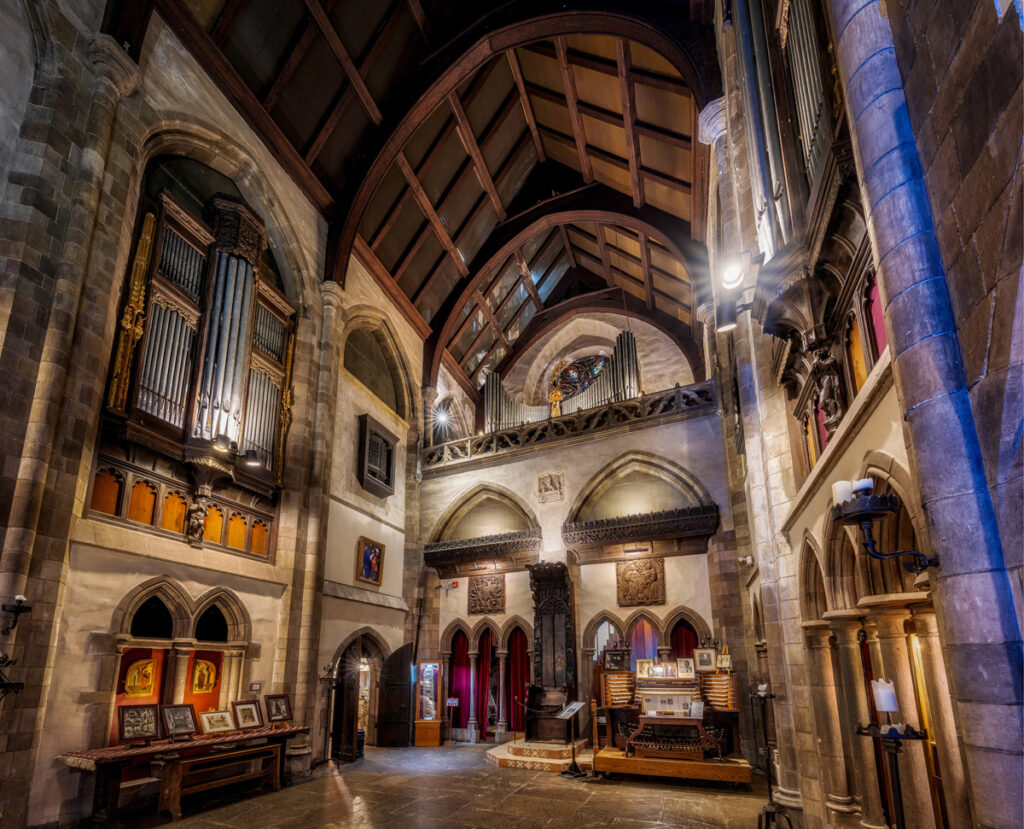The newly restored 12th- and 13th-century French cloister arches overlooking the sprawling coastline may be one of the most Instagrammable spots in town, but Gloucester’s Hammond Castle Museum goes far beyond the flash of an iPhone.
Tucked deep inside the medieval-style residence built by inventor John Hays Hammond Jr. is a subterranean space known as the War Room. Inside, you’ll find Eric Pape’s 22-foot mural, “The Wireless Naval Battle of Gloucester Bay,” which depicts the Imperial German Navy attacking Gloucester in the First World War. While the story the 1918 mural tells may not be real, the American artist and former Cape Ann resident’s collection certainly is. It returns to the museum for a new exhibition, “Gertrude Cawein at Hammond Castle Museum,” opening on April 6.
A few years ago, Dr. Gregory Conn, one of the world’s leading Pape experts and biographers, heard that the museum had ownership of the prominent mural.
“He came in and looked at our mural, and said, ‘I think this is probably the last mural in existence that Pape did, and I’d very much like to restore it for you,’” executive director Linda Harvey recalls.

In dire shape, the mural underwent an extensive restoration that took about a year to complete. Dr. Conn said he’d like to have an exhibit that highlighted Pape’s various paintings that adorn the museum, as well as several others pulled from his 200-piece collection and other area museums. The April exhibit, one of the largest ever of Pape’s work, will include 60 pieces from the prolific artist’s collection. “Gertrude Cawein,” a full-length portrait, is one of the rarest pieces to be included and is on loan from the Filson Historical Society in Louisville, Kentucky, for the first time.
A California native, Pape made his way to Massachusetts when he married illustrator Alice Munroe. He went on to teach at the Eric Pape School of Art in Boston, educating some of the most prominent American artists of his time, including N.C. Wyeth. He became deeply involved in the plein-air arts scene on the Massachusetts coast, and held a summer residence on Cape Ann. In 1907, he was commissioned by the city of Gloucester to produce the “Tablet Rock Memorial” that sits in Stage Fort Park, and formed a complex relationship with Hammond. Following the death of Pape’s wife Alice, he sent his son Moritz to stay at Hammond’s estate for some time. Moritz would later write that Hammond was more of a father to him than Pape himself.


When guests come to see the Pape exhibit, they can explore and view the rest of the museum, which was built between 1926 and 1929, as a self-guided tour. The Great Hall, where the Pape exhibit will take place, features towering 56-foot ceilings and endless religious art and artifacts. Designed to have perfect acoustics thanks to its soft and hollow walls, it once served as an additional laboratory for Hammond’s inventions and now houses some of the museum’s most important collectibles. There, you’ll find everything from a 15th-century Catalonian choir stall from the cathedral at La Seu d’Urgell in modern Spain to a reproduction of Duccio di Buoninsegna’s “Rucellai Madonna,” the largest 13th-century panel painting still in existence. Hammond himself salvaged some of the pieces from World War I buildings.
“There’s a lot of beautiful art in this museum, to begin with,” says Harvey. “And this is all collections of things that Hammond collected himself and brought here.”
Hammond’s legacy is an important, yet elusive one for many who aren’t familiar with him.



“Most people haven’t heard of Hammond before, and that’s a little bit off, considering that he is, objectively speaking, one of the most prolific inventors in American history,” says Caleb McMurphy, director of education at the Hammond Castle Museum, who notes that Hammond had more than 400 patents to his name. Best known for his contributions to the world of radio control, Hammond set up the space as a museum in 1930 and continued to live there as it operated until the time of his death in 1965.
While he was the son of one of the wealthiest men in America at that time and rubbed shoulders with Vanderbilts, Rockefellers, politicos, and Hollywood’s most prominent figures (even George Gershwin played Hammond’s piano, and signed the guest book in 1926 with a music staff filled with notes from “Rhapsody in Blue”), Hammond’s main intent was to preserve the castle for the community.
“He always intended the building to serve as a museum to the public, and that’s very core to Hammond’s mission here,” McMurphy continues. “He intended to leave this place as Hammond Castle Museum for you and me.”
“Gertrude Cawein at Hammond Castle Museum,” an exhibit of nearly 60 works of art by Eric Pape, runs April 5–28 at the Hammond Castle Museum. hammondcastle.org

